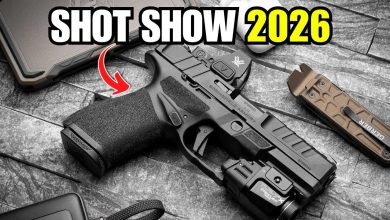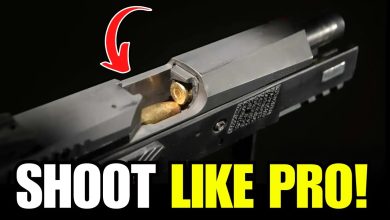Rifles: Staying On Target

Fixing a new accuracy problem might be solved by tightening mounting screws, checking the bolt or upgrading the trigger.
If you spend enough time behind rifles, eventually you’ll encounter one that stops hitting the mark without warning. Whether it happens during a slow range day, in the middle of a competition stage or when accuracy really matters, it’s aggravating, at best. Oftentimes though, the cause is simple enough to remedy yourself.
User-fixable problems vary by action type. For example, inconsistent action-screw torque is a bolt-gun issue that can lead to erratic shot placement. Consistently adhering to the manufacturer’s recommended torque settings—and checking them periodically—should take this issue out of the accuracy-robbing gene pool.
While freefloat barrels are increasingly common in off-the-shelf bolt-action rifles, older models and new, lower-cost, conventionally stocked rifles tend to have
some amount of fore-end impingement. Enlarging a stock’s barrel channel is a fairly easy task when contact is minor. Large- and medium-grit sandpaper, a barrel-diameter dowel section and the patience to sand a little, test-fit and repeat are the primary tools. Reasonably priced tools are available for more extensive channeling work, but they may not be cost-effective for a one-off job.
Rigid action seating also plays heavily into turnbolt accuracy. If your rifle lacks a bedded action, an aftermarket replacement that employs a bedding block or aluminum chassis may be available. If that’s not feasible, you can bed the action yourself.
While not difficult, this task is worth researching to avoid making costly mistakes. Ample instructional resources are available, including books, short classes (such as those offered through the NRA’s Gunsmithing Schools program) and web guides. MidwayUSA’s founder, Larry Potterfield, has posted several demonstration videos on this topic, as well as others, to common streaming platforms.
Barrel freefloat is equally important to accuracy on the semi-automatic side of the house. Modern sporting rifle gas blocks should be inspected to ensure they aren’t contacting the adjacent handguards or internal accessory hardware. Sling QD tips and M-Lok T-nuts are common culprits that can also impinge on the heavier-contoured chamber portion of a barrel.
When semi-auto bolt-carrier speeds vary widely from shot to shot, differences in cartridge-seating force can change points-of-impact. At the same time, rough or erratic cycling can affect the way a rifle handles and the shooter’s ability to be consistent. Some causes of variable cycling, like ammunition inconsistencies or decreasing magazine feed-lip friction with successive shots, are unavoidable. But, other problems can be reduced or even eliminated.
Piston systems that employ an operating rod passing through the front of a receiver should be checked for binding in that area. Gouges or drag marks on the rod or inside a receiver bushing, however slight, should be carefully polished out so that the surfaces are mirror smooth. Rods should also be checked to ensure they’re straight and gas blocks checked to verify that they are properly aligned.
A similar problem can occur when the bolt-carrier key in an AR-style, direct-gas-impingement system is no longer aligned with the gas tube. To check this, first verify the gas key is undamaged and its screws are still tight. Next, slowly insert the stripped carrier into the upper receiver by hand and then slide it forward while applying slight upward pressure to the bottom of the carrier as it advances.
The key should slide smoothly over the end of the gas tube, or at most, have a barely noticeable bump as the two meet. If they hang up or bind—and assuming the gas block is properly aligned with the receiver—the open end of the gas tube can be realigned using mild, lateral pressure with a Delrin or brass punch. Alternatively, the tube can be removed and its bends altered until alignment with the gas key is achieved.
Several trouble spots are common across multiple rifle types. Significant carbon build-up where a barrel’s crown transitions to the muzzle face can affect the consistency of how projectiles exit the bore. Careful removal with a carbon-dissolving cleaner and a stiff nylon-, bronze- or brass-bristled brush usually does the trick here. While crown nicks and burrs pose bigger problems than carbon caking, repairing them typically falls into the gunsmith’s realm.
Over-torquing of muzzle devices is an invisible problem that can impart unrelieved stress on the thinner steel of a threaded muzzle. This stress then contributes to point-of-impact shifts as the material is heated. A different, measurable result is that as a muzzle device is tightened beyond specs, the barrel’s inner diameter shrinks.
A master machinist friend recently gave an explanation for this: As torque increases beyond the recommended maximum, the seated muzzle device will stretch the barrel’s threads, reducing bore inner diameter (at the muzzle) in the process. While a tight bore can aid accuracy in some cases, it can interfere in others. Sticking with manufacturer-specified muzzle-device torques is the best way to avoid these types of problems.
A rough trigger is fairly easy to remedy today, thanks to aftermarket drop-in options for an ever-widening variety of rifle types and models. DIY trigger jobs are still doable, but for safety’s sake, this work is best left to a pro if you aren’t confident in working on these critical engagement surfaces.
Sometimes, the rifle isn’t the issue at all. A threaded suppressor that gradually loosens or a QD suppressor-latch system with free play will make on-target consistency difficult to achieve. Ensuring suppressors are tightened before shooting, and periodically re-checking them, are simple habits worth developing.
Intermittently, I encounter loose receiver rails, scope rings and even iron sights “walking” out of their dovetails on test rifles and customers’ guns. Check the manufacturer’s specs for scope and base screw torques, and for bolt-on receiver rails, a mild thread-binding compound provides extra insurance. Only a tiny bit is needed and it’s important to ensure that if any of the tapped receiver holes go through to the action, none of the binding compound sets up inside the receiver.
If everything else checks out OK, a simple swap from one sighting system to another can rule that out as the problem. The extra riflescope in my range bag has helped identify several optics that suddenly developed internal problems over the years. Likewise, changing to a different ammunition type helps determine whether a rifle simply doesn’t like a particular load, or if a specific ammo lot could be the trouble.
There are other ways to tighten up rifle accuracy, but the tooling and skills needed add costs and time that many rifle owners don’t want to part with. If your rifle still performs poorly after doing what you can to troubleshoot, it’s a safe bet that you won’t have far to look for a well-equipped gunsmith with a solid track record who can help get you back on target.
Read the full article here









